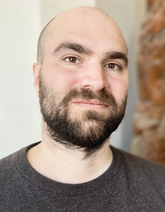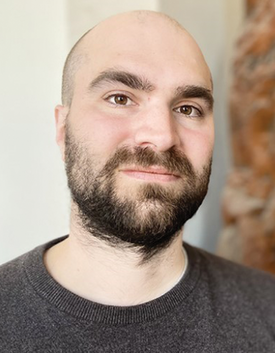Fredrik Schaufelberger
Graphical Abstract
“The most inspiring lecture I ever attended was part of a supramolecular chemistry course by the legendary François Diederich, where I first learnt about the mechanical bond… The most exciting thing about my research is that we not only get to make incredibly cool molecules like rotaxanes, catenanes and knots, but also think about how to use them to improve our lives…”
Find out more about Fredrik Schaufelberger in his Introducing… Profile.

|
Position, Location: | Assistant Professor of Synthetic Chemistry, University of Warwick (UK) |
| Homepage: | https://www.schaufelberger-group.com/ | |
| ORCID: | orcid.org/0000-0001-5298-4310 | |
| Education: |
2007–2012, Undergraduate studies, KTH Royal Institute of Technology, Stockholm (Sweden) 2012–2017, PhD supervised by Olof Ramström, KTH Royal Institute of Technology, Stockholm (Sweden) 2017–2020, Postdoctoral position supervised by David A. Leigh, University of Manchester (UK) 2020–2021, Postdoctoral position supervised Molly M. Stevens, Imperial College London (UK) |
|
| Research: | Supramolecular chemistry, mechanically interlocked molecules, dynamic covalent chemistry, soft materials, biomaterials | |
| Hobbies: | Reading, spending time with family, Lego, video games |
Chemistry is fun because it is the perfect blend between problem-solving and creating something new.
The biggest scientific advance since I was a student has been the ability to harness the power of radicals in synthetic chemistry. Organic chemists have completely rewritten the book on how to make molecules in the last decade or so.
The most inspiring lecture I ever attended was part of a supramolecular chemistry course by the legendary François Diederich, where I first learnt about the mechanical bond. I was so blown away by these crazy structures that later that night, in the bar, I couldn't talk about anything other than rotaxanes and catenanes with my undergrad friends.
The most exciting thing about my research is that we not only get to make incredibly cool molecules like rotaxanes, catenanes, and knots, but also think about how to use them to improve our lives. While mechanically interlocked molecules have been around for decades, trying to make them useful in our everyday lives is an extraordinarily exciting challenge.
The most amusing chemistry adventure in my career was during my postdoc, when we quite literally spent several working days folding pipe cleaners from a “Crafting Kit for Children” to try to figure out the stereochemistry of our molecular knots.
The most rewarding part of my job is when I see my students come up with ideas and solutions that I had never thought of myself.
One thing I was not good at in my the lab that I now really enjoy is running flash columns because it is so satisfying when you get into that magic flow and manage to separate a tricky compound using 25% wits, 25% muscle memory and 50% voodoo.
I am most proud of my research group when we work together as a team and take part in each other's successes and setbacks. Incredibly proud to work with such smart and talented, yet equally kind and caring people.
My group has fun by playing video games, going to the pub and having the occasional karaoke session.
The most important thing I have learned from my students is that everyone is different. We each have different things that drive us, and different ways of working. If you do not respect or understand that about your students, you will never be able to help them achieve their full potential.
When I want to treat myself to something, I spend time building Lego sets, either by myself or with my sons.
If I were not a scientist, I would be a writer of really lousy sci-fi novels.
The advice I wish I had received is that science is a marathon, not a sprint. Some things just take time, and proper pacing is essential for success.
The book currently on my bedside table is Under the Eye of the Big Bird by Hiromi Kawakami.
My favorite quote is: “The only real mistake is the one from which we learn nothing.” - Henry Ford
Behind the Science
This paper was extra fun for us as it started out as a small model study and turned into a whole research program. As part of our work on rotaxane biosensors, we wanted a compound where we could study energy transfer between rotaxane co-component in a way where we could be certain that we only saw energy transfer over close distances. Antenna-sensitized lanthanide luminescence fits that bill, so our amazing PhD student Anja developed the key compound scaffold in the paper. However, we quickly realized we had prepared a class of molecules with far more interesting and diverse properties than we initially had anticipated, as exemplified in this paper and many more to come.
The author presented on this page has published his first article as a submitting corresponding author in Angewandte Chemie:
“Modulation of Lanthanide Luminescence with the Mechanical Bond: Antenna-Emitter Confinement in a Compact [2]Rotaxane”: <other>A. Ramström, D. R. S. Pooler, H. Abasov, M. Tomar, S. Crespi, F. Schaufelberger, Angew. Chem. Int. Ed. 2025, 64, e202505666.
International edition: DOI: 10.1002/anie.202514011
German edition: DOI: 10.1002/ange.202514011





